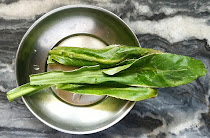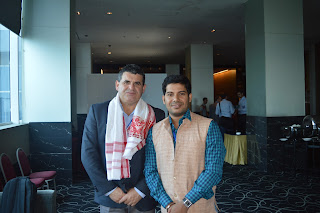Colocasia Chicken: A very popular Tiwa recipe
Northeast India, especially Assam is very rich in its cultural diversity. This part of India is having different ethnic tribal groups like Bodo, Mishing, Tiwa, Kochari, Karbi, Dimasa, etc. and each group is having their different cultures.. different feeding habits.
It was my friend Barnali Amphi Manta who introduced me to my today's special recipe. Being an active member of the Tiwa literary society, Barnali is having enormous knowledge of their tradition and culture. She is one of my closest friends from the virtual world and we often use to tease each other a lot !
This morning I was talking to her over the phone and was asking about a delicious chicken recipe of the tiwa community. She described the procedure on how to cook colocasia chicken very nicely and hence I have cooked this special chicken recipe for my lunch ! The taste is like "out of the world" and you should definitely give a try! Let's have a look at the step by step procedure on how to cook colocasia chicken in Tiwa style.
What I took to prepare the recipe:
• Chicken: 250 g
• Colocasia root: 100g
• Ginger-Garlic mix: 1ts
• Onion: 3 small nicely chopped
• Green chili: 3 (large) grinded with the ginger-garlic mix
• Turmeric
• Salt to taste
• Black pepper
• Mustard oil
• Thai coriander
 |
| 3 Onions nicely chopped |
 |
| Ginger-Garlic-Chili mix |
 |
| Colocasia root cut into medium pieces |
 |
| Thai Coriander |
Procedure:
• Clean the colocasia root (taro) in a pressure cooker for 3 whistles. Leave it aside.
• Marinate the chicken with salt, turmeric, black pepper powder, lemon juice, and a bit of oil.
• Fry the nicely chopped onions and ginger, garlic, chili mixture for 2-3 mins in medium flame.
• Add the chicken and fry for 10-15 mins. When the chicken started leaving the oil, add the boiled colocasia root with the water.
• Cook it until a nice and thick gravy.
• Add some Thai coriander to enhance the taste.
 |
মাংস বাটি দেখিয়ে লোভ লগা নাইনে বাৰু ? |
কচুৰে কুকুৰা মাংস: এটি খুব জনপ্ৰিয় "তিৱা" ৰেচিপি
উত্তৰ পূৱ ভাৰত সংস্কৃতিৰ বৈচিত্ৰতাত খুবেই চহকী ৷ ভাৰতৰ এই অংশটোত বড়ো, ৰাভা, মিচিং, কচাৰী, কাৰ্বি, ডিমাচা আদিৰ মিলনভূমি আৰু আটাইবোৰ জনগোষ্ঠী নিজৰ নিজৰ সংস্কৃতি, ঐতিহ্যত তথা খাদ্যভাষত চহকী ৷
মোৰ বান্ধবী শ্ৰীমতী বৰ্ণালী আম্ফি মান্তাই মোক আজি ৰান্ধিব লোৱা ৰেচিপিটোৰ লগত চিনাকি কৰি দিলে ৷ বৰ্ণালী নিজেই এগৰাকী তিৱা সাহিত্য সভাৰ সক্ৰিয় সদস্য আৰু সেয়েহে তিৱা জনজাতিৰ সাহিত্য আৰু সংস্কৃতিৰ ওপৰত অবাধ জ্ঞান আছে ৷ ভাৰ্চুৱেল জগতখনত চিনাকি হোৱা বৰ্ণালী মোৰ এগৰাকী অতি ঘনিষ্ঠ বান্ধবী ৷
আজি ৰাতিপুৱা তাইৰ লগা ফোনত কথা পাতি থাকোতে তিৱাসকলে কিদৰে মাংস ৰান্ধে সুধিলো ৷ তাই ক'লে যে তিৱাসকলে মাংসত আলুতকৈ কচু দিয়াতো বেছি অগ্ৰাধিকাৰ
দিয়ে ৷ তাইৰ পৰামৰ্শ অনুযায়ী আজি ৰান্ধি চালো তিৱাসকলৰ মাজত খুবেই জনপ্ৰিয় কচুৰে কুকুৰা মাংস ৷ সোৱাদৰ কথা ক'বলৈ মোৰ লগত শব্দ নাই ৷ কিদৰে ৰান্ধিলো চাওঁচোন আহক:
ৰেচিপিটো ৰান্ধিবলৈ মই কি কি ল'লো:
• ব্ৰইলাৰ মূৰ্গী: ২৫০ গ্ৰাম
• কচু: ১০০ গ্ৰাম
• আদা নহৰু: ১ চামুচ
• পিঁয়াজ: ৩ টা (সৰু)
• কেঁচা জলকীয়া: ৩ টা (ডাঙৰ): আদা নহৰুৰ লগত খুন্দি ল'লো
• হালধি
• নিমখ সোৱাদ অনুসাৰে
• জালুকৰ গুৰি
• মিঠা তেল
• মান ধনীয়া
 |
| কচুৰে ৰন্ধা কুকুৰা মাংসৰ সৈতে এসাজ ভাত |
* কচুৰ বাকলি গুচাই ভালদৰে চাফা কৰি প্ৰেচাৰ কুকাৰত সিজাই ল'লো ৷
* নিমখ, হালধি, অলপমান জালুকৰ গুৰি, নেমুৰ ৰস আৰু অলপমান মিঠাতেলৰ সৈতে মাংসখিনি ভালদৰে মঠি ল'লো ৷
* প্ৰায় ২-৩ মিনিটৰ বাবে মধ্যমীয়া জুইত মিহিকৈ কটা পিঁয়াজ আৰু খুন্দি লোৱা আদা-নহৰু-জলকীয়াৰ মিশ্ৰণটো ৰঙা হোৱাকৈ ভাজি ল'লো ৷
* তাতে মাংসখিনি দি ১০-১৫ মিনিটৰ বাবে ভালকৈ ভাজি ল'লো ৷ যেতিয়া মাংসৰ পৰা তেল ফুটিবলৈ আৰম্ভ কৰিলে সিজাই লোৱা পানীৰ সৈতে কচুকেইটুকুৰা মাংসত ঢালি দিলো ৷
* মাংসখিনি ভালকৈ সিজি এখন ডাঠ আঞ্জা হোৱালৈ উতলাই থাকিলো ৷
* শেষত মিহিকৈ কাটি লোৱা মান ধনীয়াখিনি দি গৰমে গৰমে পৰিৱেশন কৰিলো ৷




Comments
Post a Comment